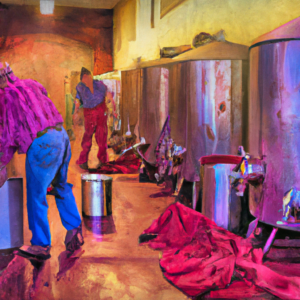Yeast is a microorganism that plays a crucial role in the winemaking process. It is responsible for the conversion of grape juice into wine, consuming the sugars and producing alcohol and carbon dioxide. Yeast also contributes to the flavor, aroma, and texture of wine, and different strains of yeast can produce unique characteristics in the finished wine.
Yeast is a single-celled microorganism that is present on the surface of grapes, as well as in the environment. When grapes are harvested, they are often covered in wild yeast, which can lead to spontaneous fermentation. However, many winemakers choose to use a specific strain of yeast to control the fermentation process and achieve the ![]() desired flavor profile. The two most common types of yeast used in winemaking are Saccharomyces cerevisiae and Saccharomyces bayanus. Saccharomyces cerevisiae is the most commonly used yeast in winemaking and is known for producing a clean and consistent fermentation. It is used to ferment both red and white wines and is often chosen for its ability to convert all of the grape sugars into alcohol, resulting in a dry wine. Saccharomyces bayanus is a slower-acting yeast that is often used in cooler fermentation conditions, such as for sparkling wine. In addition to these two primary types of yeast, there are also many wild and proprietary strains of yeast that winemakers may choose to use. These strains can contribute to the aroma, flavor, and mouthfeel of the finished wine. For example, some strains of yeast are known for producing fruity or floral aromas, while others can contribute to a creamy or buttery texture. Yeast converts the sugars in grape juice into alcohol and carbon dioxide through a process called fermentation. During fermentation, yeast consumes the grape sugars, breaking them down into alcohol and carbon dioxide. The alcohol gives wine
desired flavor profile. The two most common types of yeast used in winemaking are Saccharomyces cerevisiae and Saccharomyces bayanus. Saccharomyces cerevisiae is the most commonly used yeast in winemaking and is known for producing a clean and consistent fermentation. It is used to ferment both red and white wines and is often chosen for its ability to convert all of the grape sugars into alcohol, resulting in a dry wine. Saccharomyces bayanus is a slower-acting yeast that is often used in cooler fermentation conditions, such as for sparkling wine. In addition to these two primary types of yeast, there are also many wild and proprietary strains of yeast that winemakers may choose to use. These strains can contribute to the aroma, flavor, and mouthfeel of the finished wine. For example, some strains of yeast are known for producing fruity or floral aromas, while others can contribute to a creamy or buttery texture. Yeast converts the sugars in grape juice into alcohol and carbon dioxide through a process called fermentation. During fermentation, yeast consumes the grape sugars, breaking them down into alcohol and carbon dioxide. The alcohol gives wine

its intoxicating properties, while the carbon dioxide is released as a gas. In still wines, the carbon dioxide is allowed to escape during fermentation, but in sparkling wines, the carbon dioxide is trapped in the wine, creating bubbles. Yeast can also contribute to the flavor and aroma of the finished wine. During fermentation, yeast produces a range of compounds that can give wine its distinctive characteristics. For example, some strains of yeast are known for producing fruity or floral aromas, while others can contribute to a spicy or earthy flavor profile. The specific strain of yeast used, as well as the fermentation conditions, can play a significant role in the flavor and aroma of the finished wine. Yeast is a living organism and requires specific conditions to thrive during fermentation. Yeast requires a warm and moist environment to ferment grape juice, and the optimal temperature range is typically between 60 and 75 degrees Fahrenheit. Yeast also requires oxygen to grow and reproduce, which is why it is important to aerate the grape juice before adding the yeast. The addition of nutrients, such as nitrogen and vitamins, can also help to support the growth and health of the yeast during fermentation. Yeast can play a significant role in the aging potential of wine. Some strains of yeast are known for producing wine with a greater aging potential, while others may produce wine that is best consumed young. Yeast can also contribute to the development of secondary aromas and flavors during the aging process. The way in which yeast is managed during fermentation and aging can have a significant impact on the quality and character of the finished wine. In conclusion, yeast is a microorganism that is critical to the winemaking process. It converts grape juice into wine, contributing to the flavor, aroma, and texture of the finished product. The strain of yeast used, as well as the fermentation conditions and aging process, can have a significant impact on the final product. Yeast is a living organism and critically important for wine production.
There are many strains of wine yeast available to winemakers, with estimates ranging from several hundred to over a thousand. The two most common strains used in winemaking are Saccharomyces cerevisiae and Saccharomyces bayanus, but there are also many wild and proprietary strains available. The specific strain of yeast used can have a significant impact on the flavor, aroma, and mouthfeel of the finished wine.
Tags, Tags, #hashtags, Tags